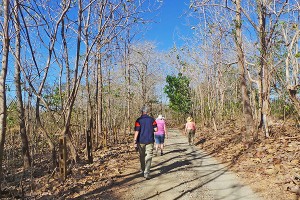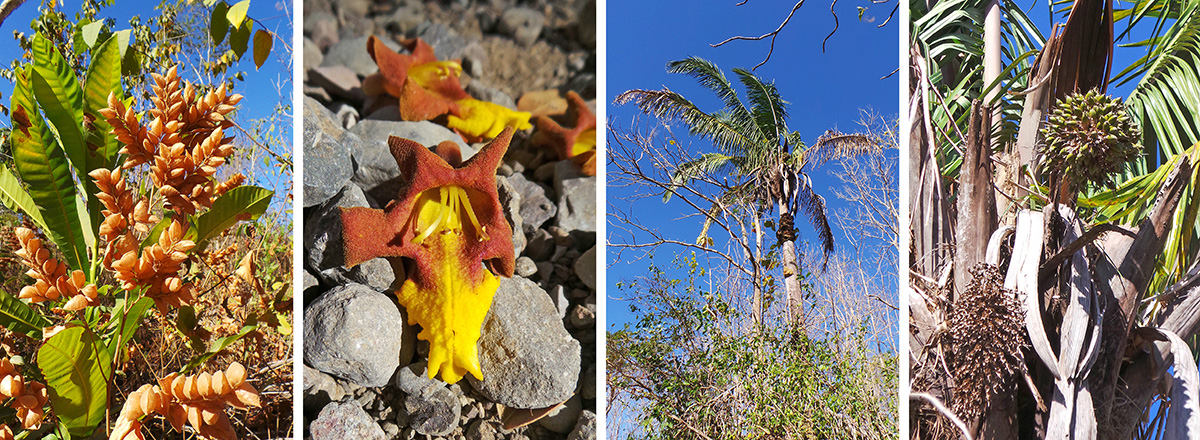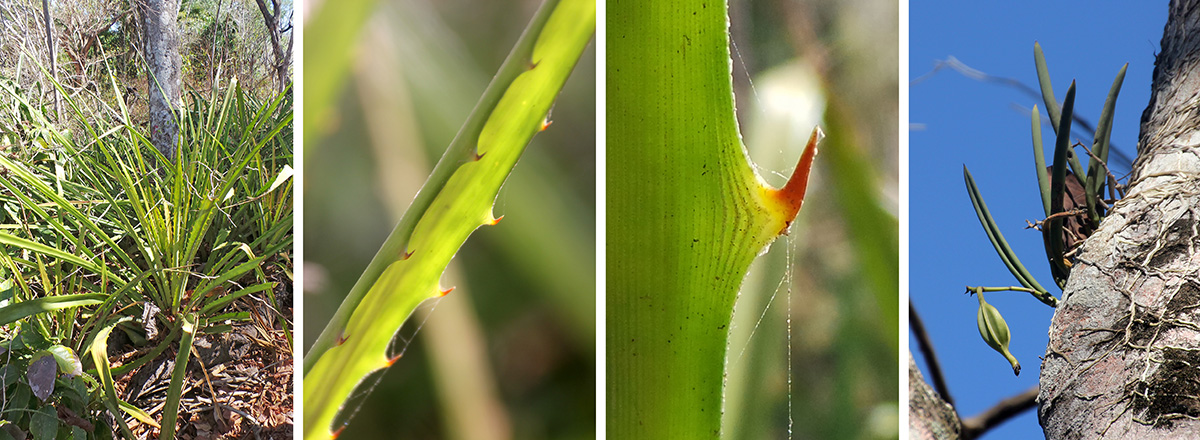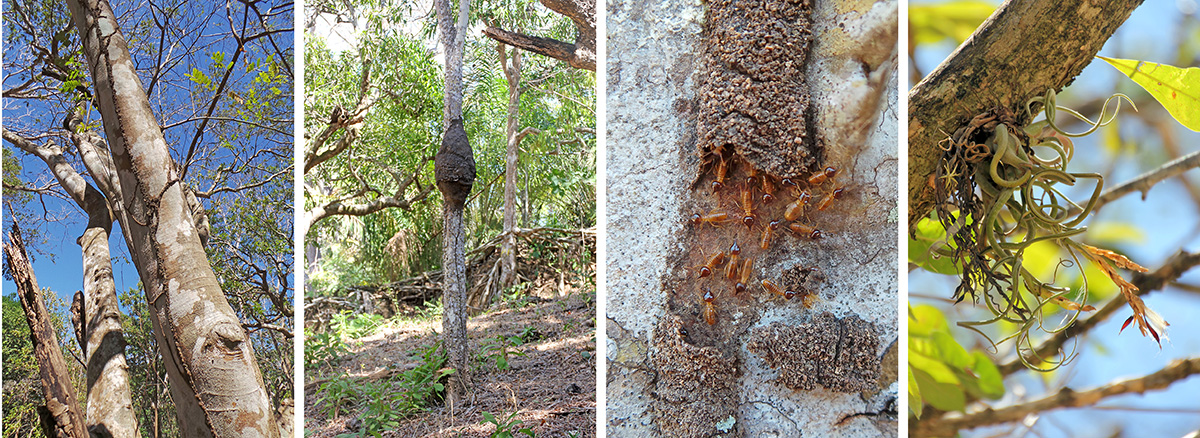Today was a free day, so everyone was on their own to relax or take the optional excursions.

The ocean from the restaurant at breakfast (L), crashing waves (C), palm trees line the beach (R).

Jim, Maureen and Carol walk through the dry tropical forest.
A few of us met in the morning to take the short hike to the waterfall. We first encountered a blooming pochote tree or spiny cedar (Bombacopsis quinatum) with its bat-pollinated white shaving brush flowers and pale greyish-brown trunk and main branches covered with hefty, hard conical spines. They can grow quite tall, often with a buttressed base and a rather wide spreading crown. The degree of spininess is extremely variable; some trees are completely spineless. The spines can be especially dense on the saplings.

Spiny cedar (Bombacopsis quinatum) tree (L), flower (LC), tree trunk (RC) and spines (R).
We saw some of the escaped ornamental wild hops from Malaysia, Flemingia strobilifera, with their interesting dried, brown flower bracts and just a few leaves. Further on there was a tall tree (something in the Bignonaceae, but we couldn’t identify it) with chestnut and yellow flowers high up on the leafless branches and fallen on the ground where we could examine them more closely. Gustavo pointed out a Scheelea rostrata palm that has edible, sweet-sour fruits and long fronds that are often used for thatching.

Brown bracts of Flemingia strobilifera (L), unknown tree flower (LC), palm Scheelea rostrata (RC) and its fruits (R).
We saw several leafless plants of Genipa americana, a small tree with smooth light grey trunk and branches and lots of egg-shaped fruits on the ends. These thick-skinned berries are edible, and can be made into drinks, jelly or for ice cream. The juice of the immature fruit is clear, but induces a chemical reaction on the human skin resulting in a tattoo-like dark blue, and was used by some indigenous peoples for that purpose. In one more open area there were several stumps where non-native teak trees had been harvested recently. We walked under a very tall rain tree, Albizia saman, so named because when large numbers of cicadas congregate in the foliage, they can excrete enough honeydew to fall like rain, even in the dry season.

Leafless Genipa americana tree with fruits (L), cut teak stump (C), looking up a large rain tree, Albizia saman (R).
Soon we got to the little stream that forms a waterfall over the rocks into the ocean below – a mere trickle right now – but instead of going down there, we first went up a short, steep path to a wooden table set on the cliff overlooking the wide beach below. There was a dramatic view of the blue ocean and small surf surging onto the black rocks and golden brown sand beach. Hanging over the cliffs were several old plumeria or frangipani trees (Plumeria rubra) with a few pelicans sitting on the branches.

Coastline (L), pelicans in plumeria tree (C), brown pelican (R).
The trees only had a few leaves and a couple of clusters of white flowers, but a lot of seed pods hanging down, a few opened to expose the ranks of flat seeds arranged like shingles on a roof inside the pods.

Old plumeria trunks sticking out over cliff above the ocean (L), plumeria flowers (LC), plumeria fruits (RC), and seeds in opened fruit (R).
Nearby, also on the rocks jutting over the water, was a nice specimen of Pseudobombax septimnatum, a relatively small tree with a single smooth trunk with a somewhat thickened base. This one had a couple of small white bottle-brush like flowers still open and a number of long, egg-shaped seed pods, but almost no leaves. On the ground near the trail here were a few plants of the large terrestrial bromeliad Bromelia pinguin, with ferocious red hooked spines along the margins of the long, light green leaves and a few orchid plants up in the branches of one tree.

Terrestrial bromeliad Bromelia pinguin plant (L), spiny leaf margin (LC), red hooked spine (RC), orchid with seed pod in tree (R).
We sat up there enjoying the view and the cooling breeze, watching pelicans, terns, and gulls soaring and diving into the water to catch fish for a long while. Then we went down to check out the little stream, green water surrounded by lush vegetation, and a few small fish and tadpoles visible in the shallow water.

Stream (L) with tadpoles in the shallow water (C) and reflections of the vegetation (R).
We were starting to get overheated by then (it was in the low 90’s by then), so began the trek back to the resort. We stopped to look at the termite nests and covered trails on tree trunks, breaking open one of the brown tunnels made of chewed up wood and termite excrement to view the small insects scurrying along their trail. Along the way there was a grey-green Tillandsia caput-medusa in a calabash tree and we spotted a zone-tailed hawk perched high up in a tree.

Termite trails go up a tall tree (L), black termite nest in small tree (LC), termites exposed in their covered trail (RC); bromeliad Tillandsia caput-medusa in a calabash tree (R).
